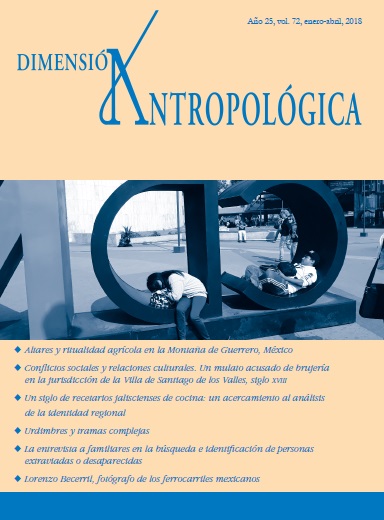Español
Keywords:
Tejido en curva, gasa con trama discontinua, tejido abierto con envoltura de trama, quechqueme, lienzos colonialesAbstract
The geographical distribution of curved weaving is related to two other weaving techniques considered exclusive to Mesoamerica. Plotting evidence of the use of curved weaving on a map shows its distribution ranges from the Mixtec region in Oaxaca to the Sierra de Puebla, the coastal plains of Veracruz and San Luis Potosí, to extend northward to Durango and reaching the American Southwest. In this essay I describe its geographical distribution in detail. I also show that curved weaving is not exclusive to Mesoamerica, for it is also used in certain regions of Ghana, Africa.
Downloads
References
Aguirre Beltrán, Hilda Judith, “El Códice Lienzo de Quauquechollac. Manuscrito pictográfico indígena tradicional azteca náhuatl. (Siglo XVI)”, 2 vols., Tesis de Doctorado, Universidad Nacional Autónoma de México, Facultad de Filosofía y Letras, Instituto de Investigaciones Históricas, México, 2000.
Albiez-Wieck, Sarah, “Contactos exteriores del Estado tarasco: influencias desde dentro y fuera de Mesoamérica”, 2 vols., tesis de doctorado, Universidad de Bonn, Facultad de Filosofía, 2011.
Asselbergs, Florine G. L., Conquered Conquistadors. The Lienzo de Quauhquechollan. A Nahua Vision of the Conquest of Guatemala, Leiden. CNWS Publications, 2004.
Christensen, Bodil, “Otomi looms and quechquemitls from San Pablito, State of Puebla, and from Santa Ana Hueytlalpan, State of Hidalgo, Mexico”, Notes on Middle American Archaeology and Ethnology. vol. III, núms. 61-90, 1947.
____________, “Otomi looms and quechquemitls from San Pablito, State of Puebla, and from Santa Ana Hueytlalpan, State of Hidalgo Mexico”, en Irene Emery y Patricia Fiske (eds. ), Looms and Their Products, Irene Emery Roundtable on Museum Textiles, Proceedings. Washington, D. C., The Textile Museum, 1977.
García Valencia, Enrique Hugo, “El morral huasteco”, en El arte de los pueblos indígenas de México (Memoria del II Coloquio Nacional de Arte Popular), Veracruz, Consejo Veracruzano de Arte Popular, 2008, pp. 29-34.
____________, “La colonización del cuerpo. Género y política en el uso del calzón y el quechquemitl”, Dimensión Antropológica, año 21, vol. 60, México, INAH, 2014, pp. 87-125.
Geertz, Clifford, El antropólogo como autor, Barcelona, Paidós, 1989.
Instituto Nacional de Lenguas Indígenas, Catálogo de las lenguas indígenas nacionales. Variantes lingüísticas de México con sus autodenominaciones y referencias geoestadísticas, México, Inali, 2009.
Johnson, Nicholas, “Lienzos made from cloth originally woven for other uses”, en Constanza Vega (coord.), Códices y documentos sobre México, México, INAH (Científica, 409), 2000, pp. 575-594.
Marcus, George E. y M. J. Fischer Michael, Anthropology as Cultural Critique. An Experimental Moment in the Human Sciences, Chicago / Londres, The University of Chicago Press, 1986.
Peck Kent, Kate, “Appendix-Additional note on Southwestern weft-wrap openwork, ‘Weft-wrap Openwork Technique in Archaeological and Contemporary Textiles of Mexico’”, Textile Museum Journal, vol. IV, núm. 3, Washington, D. C., 1976, pp. 63-74.
Stresser-Péan, Claude, De la vestimenta y los hombres. Una perspectiva histórica de la indumentaria indígena en México, México, FCE / Centro de Estudios Mexicanos y Centroamericanos / Fundación Alfredo Harp Helú / Museo Textil de Oaxaca, 2012.
Sutherland Rattray, Robert, Religión & Art in Ashanti, Londres, s.e., 1959.
Weitlaner Johnson, Irmgard, “Un antiguo huipil de ofrenda decorado con pintura”, Revista Mexicana de Estudios Antropológicos, vol. 15, México, 1958-1959, pp. 115-122.
____________, “Análisis textil del lienzo de Ocotepec”, en Summa Anthropológica, Homenaje a Roberto Weitlaner, México, INAH, 1966.
____________, “Weft-wrap openwork techniques in archaeological and contemporary textiles of Mexico”, Textile Museum Journal, vol. IV, núm. 3, 1976, pp. 63-74.
____________, Los textiles de la cueva de la Candelaria, Coahuila, México, INAH (Científica, 51), 1977.
____________, A Rare Kind of Mexican Gauze, Leiden, Rijksmuseum voor Volkenkunde, 2004.



